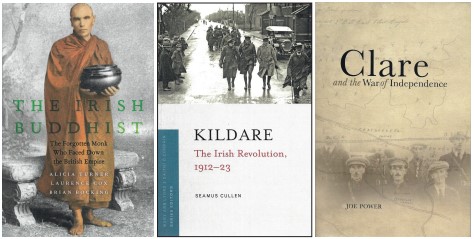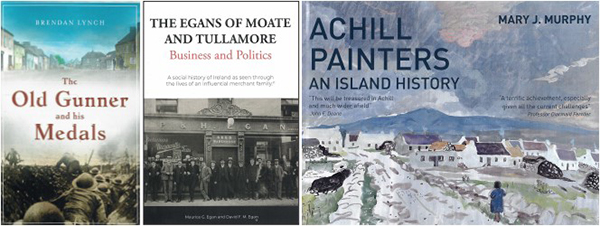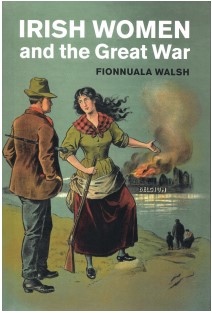BOOKWORM
Published in Book Reviews, Issue 6 (November/December 2020), Reviews, Volume 28By Joe Culley
@TheRealCulls
Who was Dhammaloka? To be honest, no one—not even the authors of The Irish Buddhist: the forgotten monk who faced down the British empire—can be entirely sure, but after ten years of detective work they’ve produced an intriguing study of the man, whoever he might have been.
He was, as they describe him, ‘this turbulent monk’: ‘white, Irish, working class, Buddhist, freethinking, teetotal, and deeply anti-colonial—he defied the myths that undergirded the colonial project, myths of race and cultural difference and the “civilising” mission’. He was, fundamentally, an agitator, railing against the pernicious presence of Christian missionaries and European (particularly British) empires in Asia at the end of the nineteenth and start of the twentieth centuries.
The most likely story is that he was born Laurence Carroll in 1856 in Booterstown, Co. Dublin. Between then and 1890, when he was ‘ordained’ as a Buddhist, he ‘crossed America as an itinerant worker (probably), became a trans-Pacific sailor (probably), lived and worked in Australia (possibly), may have been a political radical/alcoholic/Salvation Army officer, worked his way to South Asia, lived in Ceylon, then Burma’. During his two decades of campaigning, he set up schools, was tracked by police and tried for sedition, and died at least twice.
The publisher’s blurb puts it this way: ‘Through his story, authors Alicia Turner, Brian Bocking, and Laurence Cox offer a window into the worlds of ethnic minorities and diasporas, transnational networks, poor whites, and social movements’—but it’s a lot more entertaining than that sounds.
The latest to hand in the always fine ‘The Irish Revolution’ series is Kildare. Author Seamus Cullen, who has previously written about insurrections in the county in 1798 and 1803, has expanded his doctoral thesis into this study. Not surprisingly, the enormous British military presence in the Curragh and surrounds had a significant effect on the political events in the county from 1912 to 1923. It meant, for example, that there was relatively little violence during the War of Independence, but at the same time it proved a gold-mine for some crucial IRA intelligence-gathering.
Things heated up during the Civil War and included a notorious case—late in 1923—when Joseph Bergin, a 23-year-old National Army captain who was suspected of passing information to the IRA, was abducted, tortured and shot dead. The man who was eventually convicted of his murder, Captain James Murray (though the book gives his name as Michael), was also believed to have been involved in the murder of Noel Lemass a few months earlier.
Interesting statistics that emerge include the fact that the Protestant population of the county fell by 69.6% between the censuses of 1911 and 1926. While this was primarily due to the departure of the British army, there remained significant land agitation in the region, which drove many away. The loss of the army also meant a huge unemployment problem around Newbridge, and Labour did well in the 1923 general election. Cullen’s prose is clear, and his study is quite accessible to the general reader.
Joe Power has produced a similar and equally accessible study of his native county in Clare and the War of Independence. He opens with two short chapters offering a review of the events specific to Clare in the general development of nationalist politics—Home Rule, Sinn Féin, the Rising, etc.—before detailing the later military action. An interesting aspect is the radically different approaches taken by the local bishops, Michael Fogarty of Killaloe, who offered full moral support to the cause, and Thomas O’Dea of Kilfenora, who counselled restraint.

One seemingly insignificant quote stood out. You may have seen the recent documentary on sexual violence in the War of Independence. Well, while addressing how the Clare IRA treated perceived ‘collaborators’, Power quotes from the memoir of Fr Pat Gaynor, who recalled: ‘The Quilty boys, with their moonlighting instincts, would drag the girls from their homes after dark and subject them to worse insults than hair clipping’. That seems a pointed euphemism. Power also asserts that the Clare IRA pioneered guerrilla warfare. You could get a lively discussion going on that in the pub.

Across the Shannon and not far up the road from Killaloe is the Tipperary village of Toomevara, where Brendan Lynch grew up and where he has set his novella, The old gunner and his medals. Lynch was inspired by his own experiences with local man Dan Doherty, who had suffered shell-shock in the Great War and was then subjected to abuse and ostracism on his return.
In the novella, Gunner Dan befriends a schoolboy, the son of the local Garda, and enlists his help in the search for his service medals, which he had buried 30 years earlier up in the fairy fort in the fields behind his cottage. Lynch allows Dan, in his conversations with the boy throughout their summer search, to tell the story of the old days in the village, his experiences of war and his treatment on his return. Although it is not marketed specifically as ‘young adult fiction’, this slim volume should appeal to budding historians. There is a gift-giving holiday on the horizon.
Incidentally, one of our recent History Ireland Hedge School podcasts, ‘Nenagh and North Tipperary during the revolutionary period’, deals directly with this topic, including the murder in nearby Silvermines of 70-year-old George Sheehan, whose son had served in the Great War. And that theme continues in a recent publication from that most prolific outfit the Offaly Historical and Archaeological Society, The Egans of Moate and Tullamore: business and politics. A prominent Catholic and nationalist family in the late nineteenth century, active in both the Home Rule movement and the Gaelic League, a number of the men then served during the Great War. On their return, several felt intimidated enough to sell up their holdings and emigrate.
 Mary Murphy is in thrall to Achill. Her new book, Achill painters: an island history, is ostensibly ‘the stories of Belgian expressionist Marie Howet and art doyenne Eva O’Flaherty’, but it is in fact a paean to the island and its people, living and dead, and the many artists who have used it as their base in the last two centuries. It is written in a most personal tone, and Murphy’s prose is imbued with a poetic sensibility. Some beautiful reproductions add to the effect.
Mary Murphy is in thrall to Achill. Her new book, Achill painters: an island history, is ostensibly ‘the stories of Belgian expressionist Marie Howet and art doyenne Eva O’Flaherty’, but it is in fact a paean to the island and its people, living and dead, and the many artists who have used it as their base in the last two centuries. It is written in a most personal tone, and Murphy’s prose is imbued with a poetic sensibility. Some beautiful reproductions add to the effect.
The highly-praised Irish women and the Great War, from UCD lecturer Fionnuala Walsh, is the first book-length study of the impact of the Great War on women’s everyday lives in Ireland, focusing on the years of the war and its immediate aftermath. According to Fearghal McGarry, ‘this pioneering exploration of women’s lived experiences provides a sophisticated assessment of the complex impact of the Great War on the status of women within Irish society and politics. It represents a major contribution to the historiography of early twentieth-century Ireland.’
Alicia Turner, Laurence Cox and Brian Bocking, The Irish Buddhist: the forgotten monk who faced down the British empire (Oxford University Press, £25.99 hb, 288pp, ISBN 9780190073084).
Seamus Cullen, Kildare: the Irish revolution 1912–23 (Four Courts Press, €22.45 pb, 190pp, ISBN 9781846828379).
Joe Power, Clare and the War of Independence (Eastwood Books, €20 pb, 260pp, ISBN 9781916137592).
Brendan Lynch, The old gunner and his medals (Mountjoy Publishing, €12 pb, 170pp, ISBN 9780951366837).
Maurice G. Egan and David F.M. Egan, The Egans of Moate and Tullamore: business and politics (Esker Press, €24.99 hb, 300pp, ISBN 9781909822191).
Mary J. Murphy, Achill painters: an island history (Knockma Publishing, €20 pb, 260pp, ISBN 9780956074935).
Fionnuala Walsh, Irish women and the Great War (Cambridge University Press, €87 hb, 230pp, ISBN 9781108491204).
















